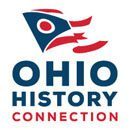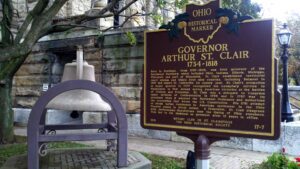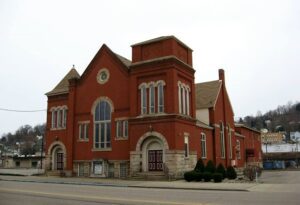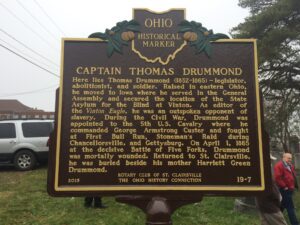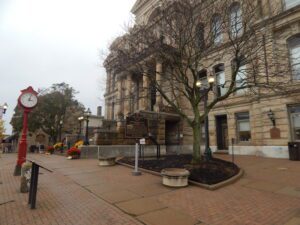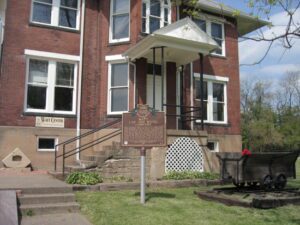, OH
Born in Scotland. From 1787-1802, was first governor of the Northwest Territory, which included Ohio, Indiana, Illinois, Michigan, Wisconsin and part of Minnesota. St. Clair established territorial court system and Ohio’s first nine counties, including Belmont in 1801 and named St. Clairsville its county seat. St. Clair’s promotion to major general in 1777 recognized his exemplary service to Washington in New Jersey during American victories at the battles of Trenton and Princeton. St. Clair was a delegate to Congress under Articles of Confederation in 1786 and in 1787 was its president when it adopted the Northwest Ordinance and authorized the convention that wrote the U.S. Constitution. His 1791 attempt to break Indian resistance to American settlement in the Ohio Country ended in bitter defeat. A Federalist, St. Clair disagreed with Jeffersonian-Republicans over the timing of Ohio statehood. This led to his dismissal as governor after 15 years in office.
, OH
Cornelius D. Battelle was born July 13, 1807 in Washington County, Ohio. He entered the Methodist Episcopal Church on October 30, 1825 and the Pittsburgh Methodist Conference in 1833. He was assigned pastoral circuit duties in rural eastern Ohio and the small river settlement of “Belle Aire” where he delivered his first sermon in a warehouse during the winter of 1838. He established the first Methodist class of eleven members in 1839 and rallied subscriptions to build the first church in the community. He served the Ohio Conference for 64 years before his death on July 2, 1897.
, OH
Here lies Thomas Drummond (1832-1865)- legislator, abolitionist and soldier. Raised in eastern Ohio, he moved to Iowa where he served in the General Assembly and secured the location of the State Asylum for the Blind at Vinton. As editor of the “Vinton Eagle”, he was an outspoken opponent of slavery. During the Civil War, Drummond was appointed to the 5th U.S. Cavalry where he commanded George Armstrong Custer and fought at First Bull Run, Stoneman’s Raid during Chancellorsville and Gettysburg. On April 1, 1865 at the decisive Battle of Five Forks, Drummond was mortally wounded. Returned to St. Clairsville, he was buried beside his mother Harriett Green Drummond.
, OH
Near this site on July 4, 1825 ground was broken in Ohio for the National Road. The National Road was America’s first federally planned and funded highway and linked the east coast of the United States to Old Northwest Territory. Albert Gallatin, President Thomas Jefferson’s Secretary of the Treasury, conceived the idea for the road and advocated for it. Construction began in 1811 at Cumberland, Maryland, but was interrupted by the War of 1812. The road reached Wheeling in 1818, but was again delayed until 1825 because of debates over the constitutionality of federal funding for road and infrastructure projects. The National Road in Belmont County began at Bridgeport on the Ohio River and ran 28.5 miles to the western end of the county at Fairview.
, OH
Joseph Watt and son James H. started a small foundry in 1862 making plow points, window sash weights, and heating stoves. Later, brothers Stewart, Ross, and John W. joined and the name became J.H. Watt and Brothers. Securing a patent for a self-oiling mine car wheel, the business expanded to this 27-acre site. In 1891, Ohio gubernatorial candidate, and later U.S. president, William McKinley, dedicated the buildings. By 1901, over 135 were employed by Watt Mining Car Wheel Company producing mine and rail cars for U.S. and foreign markets. The Watt Car and Wheel Company was sold in 1966 to German interests and closed in 1996, ending an era of employment for generations of local people.
, OH
King Solomon “Sol” White was born in Bellaire on June 12, 1868. A Baseball legend, he was an all-around player, manager, and organizer in the Pre-Negro Leagues (1887-1912) and the Negro Leagues (1920-1926). White first played with integrated baseball clubs the Bellaire Globes (1884-1886) and Wheeling Green Stockings (1887). After 1887-1888 color barriers were imposed on baseball, White played on segregated minor league teams. They included: the Pittsburgh Keystones, Cuban Giants, York Colored Monarchs, Cuban X-Giants, Page Fence Giants, and Chicago Columbia Giants. As a coach, he helped organize and lead the powerhouse Philadelphia Giants to their 1904-1907 championships. White died on August 26, 1955, and was buried in an unmarked grave in Staten Island’s Frederick Douglas Memorial Cemetery. In 2006, “Sol” White was posthumously inducted into the Baseball Hall of Fame.

